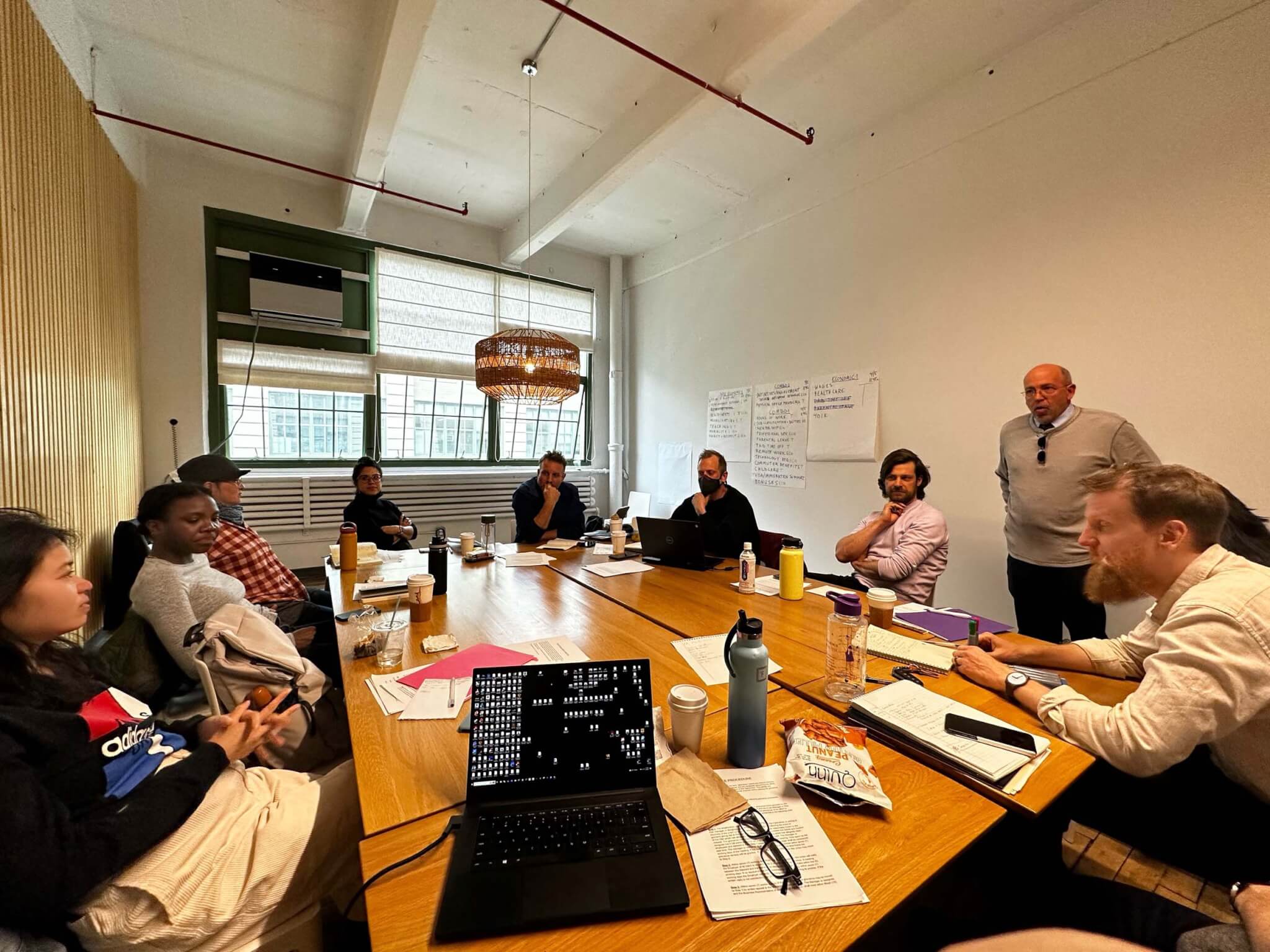Anxieties related to artificial intelligence (AI) and automation occupy much of the current discourse surrounding the 21st century labor movement. Perhaps the most visceral example was the recent writers and actors strikes in Hollywood, where AI was a central issue in the fraught negotiations between workers and management. While the Writers Guild of America (WGA) won major concessions from the Alliance of Motion Pictures and Television Producers this October, they are far from alone in their concerns. As automation and AI increasingly put architectural workers into a state of precarity, what can we learn from the most recent developments in Hollywood?
Learning from the Writers Guild of America
We, the authors—two unionized employees at Bernheimer Architecture (BA), both serving on the Bargaining Committee—think now is a critical time to seriously consider the consequences of AI-backed automation in architecture. Through our unionization effort at BA, we have come to learn the benefits of collective action, and believe that any effort confronting the use of AI and other technology in architecture requires the strong voice of those who understand production best—not software developers or firm owners, but workers. In our latest union contract at BA, we took cues from WGA that protects us from the looming threat of automation that perhaps other architectural workers can learn from.
While the actor’s strike is still ongoing, writers have achieved not only increased pay and job security, but equally important “guarantees that artificial intelligence technology will not encroach on writers’ credits and compensation.” Such protections for workers would never have been secured without the backing of unions and intersectional solidarity between multiple labor groups. Similarly, auto-workers, through the UAW, have secured tentative agreements from GM to fold electric battery plants into the national contract, a significant win in the fight over worker involvement in fast-growing and critically important EV development. At Bernheimer Architecture, we are currently negotiating similar language into our contract, reaching tentative agreements that recognize the dignity of human-centered work and design, create avenues for employee participation in decisions surrounding technology and software, and also specifically protect employees from digital monitoring.
At the BA Union, we arrived at these provisions after surveying the bargaining unit in order to assess the priority of issues to be addressed in our first contract. Surprisingly, even though technology is a recurring topic of discussion, it was not at first an item on top of the bargaining unit’s list. But one of the original priorities was “improved job security” which AI and automation indeed threatens. Under capitalism, technology stands as an antidote to job security stemming from AI, automation, and other rapid developments. Our experiences as a union thus far have taught us that it is only through an organized labor force that we are sure not to get scripted out of our jobs.
Toward UTOPIA
It’s worth noting that we, as architectural workers, don’t believe that technology is preternaturally a threat to our livelihoods, nor are unions inherently anti-tech. Under democratic, worker control, it’s possible to leverage technology to improve working conditions and society more broadly, and we have history to prove it. To envision greater worker control over technology in the United States, there are lessons to be learned from foreign countries with historically strong welfare states. In Sweden, the UTOPIA project that lasted between 1981 and 1986 is a case-in-point.
UTOPIA was a case study for creating a system of unprecedented worker involvement in technological development that architects in the U.S. can learn from. The program’s goal, as scientist Robert Howard explained in his article for MIT Press Review, “UTOPIA: where workers craft new technology,” was to help unions translate their social values regarding job skills, quality of work, and quality of products into new computer hardware and software for the printing industry specifically. In his article, Howard wrote: “These ‘action research’ projects spread throughout Scandinavia in metalworking shops, chemical refineries, railroad repair shops, insurance offices, retail stores, and newspaper offices. They quickly took on the form of a popular-education movement. Workers began to understand technology as something they might be able to influence.”
In short, UTOPIA was established as a trade union–based program for training workers to leverage computer technology and increase workplace efficiency and labor organization, with a focus on text and image processing in the graphic industries. For the project, two different social groups were brought together: system designers, computer scientists, and work-efficiency experts on one hand; and on the other hand, activists and officials from unions representing some 120,000 printers, typographers, lithographers, and other skilled workers in the newspaper and printing industries of the five Nordic countries.
Although it was short-lived, UTOPIA’s impact can still be felt today. In the MIT Press Review, Robert Howard described his visit to UTOPIA’s lab in Sweden in 1985. He illustrated a scene that could have taken place at a research department in any high-tech company: an individual doing their usual tasks interfacing with a computer screen, and a computer scientist jotting down observations. In Howard’s illustrative vignette, both scientist and worker were part of the same experiment, and both aimed to understand how, together, they could improve the tools being used to produce. This brief but enlightening experiment demonstrated, in real working conditions, that alternative technological and organizational solutions for newspapers could be developed, giving possibilities for graphic workers to improve their skills and keep their jobs. Another achievement to note was the creation of a series of guidelines for what workers should require of new technologies or organizations when in collective bargaining.

Building Together
UTOPIA may have been created out of an unusual set of circumstances, and success stories in Sweden—a country backed by a solid welfare state—don’t always translate to success in the United States. The Swedish government primarily funded UTOPIA, strong unions backed it, companies were cooperative, and radical scientists from the 1960s were eager for experimentation. All of these parties had interests in the success of the project beyond profit-making.
Although we cannot replicate that specific historical moment, we are actually living in an unprecedented time that might allow for it: Architects, who had been one of the last few groups of professionals left without union representation, now have their first unionized private-sector architecture firm in the United States: Bernheimer Architecture. In recent news, a second architecture practice has joined the ranks, Sage and Coombe Architects Union, and our near future is looking promising with possibly a handful of other firms set to unionize, thanks to the efforts of the Machinists and the Architectural Workers United. While BA Union has achieved wins regarding technology, industry-wide change will not be possible without adding many more firms to our growing movement.
A similar program to UTOPIA in the architecture industry wouldn’t bring about “utopia,” or solve all our technological problems. However, it would go a long way to rebuild the fractured relationship between those who develop our software and those who use it. Our call is not one of complete control, or total abandonment, but meaningful participation.
Call to Action, Today
One step our industry has already taken in this direction happened in 2020, when a group of several architecture offices penned a letter aimed squarely at Autodesk, by far the largest monopoly in the realm of design software. The letter was written out of frustration over rising costs of Revit and AutoCAD, among others, that showed little signs of improvement in the upgraded software’s actual productivity. Two years later, a second open letter by the signatories took aim at the fact that Autodesk does little to incorporate feedback from the architects who use their software into their new designs. [The full letter can be viewed here.]
Despite this earlier pushback, Autodesk has recently teamed up with venture capital firms to help architects “manage their drawing sets more efficiently” Autodesk claimed; a development that some worry could make drafters obsolete in the coming years. Meanwhile, Adobe is developing “generative rendering” software to aid architects during schematic design, spelling out a potential threat for younger designers who produce renderings and conceptual drawings.
Perhaps most directly, Autodesk could go beyond merely listening and instead invite users to participate in the front-end development of software, using the UTOPIA model as a precedent. At the very least, there should be transparency regarding what exactly Autodesk does with the input solicited; currently, there are surveys and “help” dialogues that end users can send information through, one-way, with little to no understanding of where it might go or if it will even be processed. However, the current status-quo isn’t serving the interest of those who use the software, with many frustrated with the inability to provide feedback and constructive criticism, echoing the recent calls for “right to repair” for smartphones and computers and the need to self-service the devices that are integral to their daily lives.
The implications of this conversation extend beyond architecture alone, as Autodesk is not just the dominant monopoly in our industry, but the entire building industry. In other words, it is not just in the interest of architects, but engineers, manufactures, and builders to call for a form of real participation in the development of the software they use. If we do, we might not only achieve union density with the architectural industry, but an entire sector at large; maybe then we can begin to envision a real utopia.
Chris Beck is an architect and writer currently serving on both the organizing and bargaining committees in the recently formed BA Union. He also teaches at Parsons and studies at the New School for Social Research.
Je Siqueira is an architect who’s been involved in unionizing efforts at two architectural firms, one which resulted in the formation of the BA Union. Je is also an active organizer within the Architectural Workers United.











